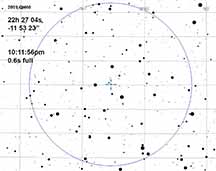


This is a lower rank event than 2000CT83, but nicely also at Kelbaker Rd and I-40. It's bright enough to be do-able 0.6s duration. We will try it from our same sites as for 2000CT83 40 minutes earlier. Charts and decision-making for the location were done just before final packing and leaving for the event, as I was able to find when two events only 40 minutes apart, would cross, and Kirk helped with this as we drove. Last minute planning possible only because Kirk was my co-pilot and constantly working on the iPhone 13 for resolving our issues.
Alt=34 in Aquarius in SSE sky.
 |
 |
 |
I observed from my same site as for 2000CT83 40 minutes earlier. Conditions were good, clear, calmer than 40 minutes earlier as far as breeze. In this case, I was about half a radius south of the centerline, and Kirk Bender was on the centerline. He had a miss, despite good odds of a "hit". A south shift happened, as I had a 0.56s positive of high confidence, at 4x integration. There was one bad time stamp, but not during the event. There was also a brief gust of wind a few seconds before the event, caused by a passing truck on Kelbaker Rd.
magDrop report: percentDrop: 78.6 magDrop: 1.673 +/- 0.609 (0.95 ci)
DNR: 4.08
D time: [05:11:18.8325]
D: 0.6800 containment intervals: {+/- 0.0201} seconds
D: 0.9500 containment intervals: {+/- 0.0494} seconds
D: 0.9973 containment intervals: {+/- 0.1063} seconds
R time: [05:11:19.3925]
R: 0.6800 containment intervals: {+/- 0.0201} seconds
R: 0.9500 containment intervals: {+/- 0.0494} seconds
R: 0.9973 containment intervals: {+/- 0.1063} seconds
Duration (R - D): 0.5600 seconds
Duration: 0.6800 containment intervals: {+/- 0.0296} seconds
Duration: 0.9500 containment intervals: {+/- 0.0667} seconds
Duration: 0.9973 containment intervals: {+/- 0.1421} seconds
 |
 |
 |
 |
 |
I humbly apologize to Kirk.... in my late rush, as the smoke forecast changed at the last minute for the better, I hurriedly searched and put together planning pages for 3 more asteroid events that would fit with our travel agenda, now heading to Needles, not Mt San Jacinto. In my rush, I did not question the Santa Cruz event time for this event of asteroid 2001 QH60. Normally, event times don't vary by more than a few seconds for the travel distances we do. But this time, the asteroid was in retrograde motion, and it turned out the event was a full 37 seconds EARLIER than the prediction time on the planning charts. Normally, even that wouldn't be fatal as Kirk and I usually begin taping no later than 1 minute before the predicted time, and usually earlier still. But this time, Kirk had trouble with telescope drift and also made the mistake of halting and deleting the recording footage at times before the final beginning of the data recording.... which unfortunately was 7 seconds AFTER the actual event. So, his data below is all after the actual event, and in fact can only be used to indicate little chance of a moonlet beginning 7s after the actual event (7s = 12 diameters, which is also usually too late to be inside the moonlet radius for known binary asteroids).
It will have to be reported as a "no observation". Kirk was just north of I-40, at the curve in Kelbaker Rd behind an asphalt pile hiding him from car headlights, infrequent at 2am on such a lonely desert road.
 |
 |
 |